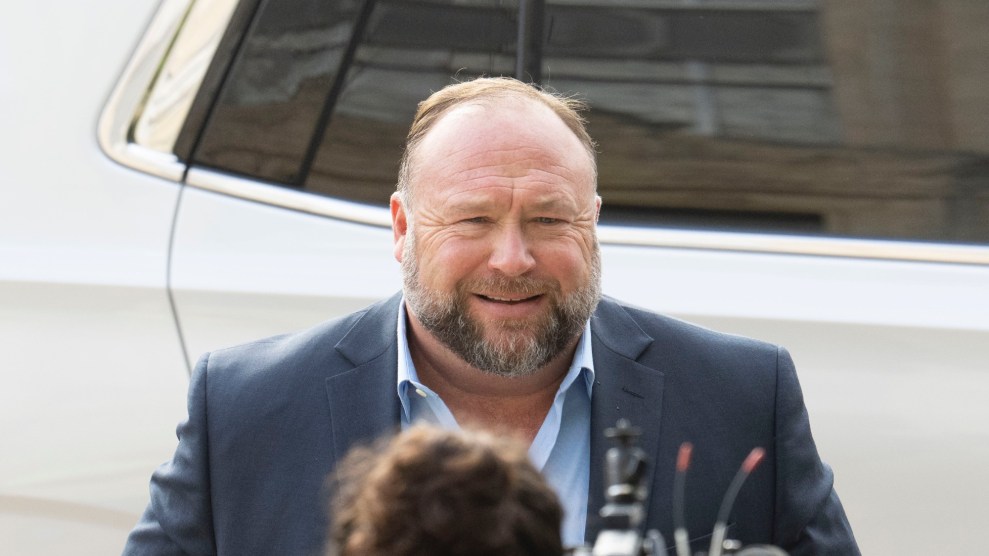
Mother Jones illustration
In 2015, Sherrod Brown didn’t want to be president. “I know you don’t believe this, but I don’t really think about it all that much,” he told the Washington Post at the time. Dayton Mayor Nan Whaley, a longtime friend of the Ohio senator who’s leading an effort to draft Brown for 2020, recalls him mocking the prospect when he was first elected to the US Senate in 2006. “He would say, ‘Oh, you know what the Senate is, it’s 100 people who want to be president,’” she recalls. “He never would have considered himself a candidate.”
But now, Brown is considering it. On Wednesday, he’ll kick off a tour of the early-primary states, a data-collecting exercise intended to help the three-term senator decide whether he’ll formally enter the presidential fray. Brown’s change of heart comes on the heels of his decisive 2018 reelection, which had Democrats instantly buzzing about his potential as a 2020 contender. The fact that he’d succeeded where Hillary Clinton failed—beating her performance by 14 points—signaled that Brown could speak a language thought to be dying among his fellow Democrats: one that appealed to the working class.
“We don’t put workers first, union or non-union,” Brown lamented to me about the Democratic Party in his Senate office hours before his tour announcement earlier this month. “I think that’s why Trump won my state ultimately, even though he clearly doesn’t put workers first.”
Unlike some of his fellow would-be candidates, Brown hasn’t spent the last few years traveling across the country to build name recognition. Some Democrats are still calling the senator “Sher-ROD” (it’s “SHER-rod”). And Brown, who hasn’t made an appearance in New Hampshire since a 2014 stop to campaign for Sen. Jeanne Shaheen, called New Hampshire’s capital “Con-CORD” (it’s “CON-cord”) when he announced his tour on MSNBC, eliciting the social-media version of a cringe from Granite Staters across Twitter.
But if Brown decides to jump into the race, catch-up may not be such a difficult game for him to play—and not only because he can connect with the white working-class voters that pundits worry have been lost to Republicans. He has a track record in lanes that are in vogue with Democratic voters, should the 2018 midterms be any indication, such as a long-standing obsession with economic inequality and a track record of advancing civil rights (though he hasn’t signed onto some initiatives favored by his party’s leftist wing, including the Green New Deal or the pledge to reject campaign contributions from fossil fuel interests).
In many respects, the 66-year-old Ohio native comes from a similar political line as Sen. Bernie Sanders—he’s just more likely to talk about how unions benefit factory floor workers than to point to Scandinavian countries’ socialist policies. Meanwhile, his hardline economic positions that favor the working class put him in close company with Massachusetts Sen. Elizabeth Warren. It’s the party’s progressive wing, who four years ago obsessed over drafting Warren into the race before putting their support behind Sanders, that’s giving Brown a hard look.
“Progressives are looking for two things: someone who can propose and make real a bold, progressive, racially inclusive vision of a country that works for everyone, and the second is someone who can defeat Trump,” says Ben Wikler, Washington director for MoveOn. “Sherrod Brown’s track record in Ohio suggests that he has ideas about where those two things can intersect.”
A concern for the American worker has defined Brown’s political career—one that’s kept him in office for 42 of the last 44 years. That wasn’t a totally natural fit for the Yale-educated son of a family doctor, but Brown became immersed in the subject after he was elected to the state Legislature in 1974 when he was just 22 years old, representing his hometown of Mansfield, Ohio, a Midwestern city that had suffered under industrial decline. (Don’t call it the Rust Belt, though—Brown is known for hand-writing notes to reporters, admonishing them for using a term he considers derogatory.)
Brown spent many Fridays at the local steel and autoworkers unions, where he learned about the financial squeeze that workers endured. “I heard some talk about their kids and grandkids and making enough and working overtime so they could send their kids to Ohio State,” he says. He kept up the conversation after he became Ohio’s secretary of state and throughout his 14 years in the House of Representatives, where he, like Sanders, broke with former President Bill Clinton and many of his Democratic colleagues to vote against the North American Free Trade Agreement. “He’s been very close to labor unions in Ohio,” explains Paul Beck, a professor of political science at Ohio State University. “This has been a signature issue for him—he’s very much anti-free-trade.”
“Members of the Senate don’t have a lot of time to sit around a union hall for two hours on a Friday, but we’ve got to make those forays into that part of America,” Brown explains as we sit in the conference room of his Senate office. He slumps in the chair across from me, wearing one of his trademark Ohio-made suits, and fiddles with his tie as we chat, often moving from one talking point onto the next idea before he’s quite finished with the prior one. Showing off his labor chops, Brown begins our interview attempting to quote our publication’s namesake, labor organizer Mary Harris Jones. (As he said it, he realized he was actually quoting Joe Hill, a contemporary of Jones, but he’s clearly versed in the organizers’ canon.)
Brown’s opening pitch as a potential presidential contender in an increasingly crowded field leans on that working-class fluency. He’s dubbed his first foray into the primary states the “Dignity of Work” tour—which builds on the vision he laid out in a 77-page policy paper he wrote at the dawn of the Trump presidency—to test a message that places the blame for flat wages squarely on the Republican Party. The remedy, Brown writes, is to move away from measuring economic prosperity by GDP growth, and instead to focus on wage growth as a more telling yardstick. “The unemployment rate is one thing, but whether workers have jobs that pay a decent wage and provide security is another,” he explained in his remarks about the paper last year. He proposes a $15 minimum wage, better paid sick and family leave, public options for retirement savings, and penalties for companies that skirt paying benefits to employees through independent contractor loopholes.
If the proposal sounds familiar, it should: Several of those ideas became the cornerstone of successful Democratic midterm campaigns, and have emerged as top priorities for the Democrat-held House. “He’s been very consistent all along in staking out progressive positions,” Ohio State’s Beck explains. In addition to his anti-free-trade stances, he’s been on the universal health care train for a long time: When he joined Congress in 1993, he pledged to pay for his own health care until Congress passed universal coverage, something he stuck with until he married his second wife, journalist Connie Schultz, who added him to her insurance plan when she was a reporter with the Cleveland Plain Dealer. Brown has been dinged for not backing Sanders’ “Medicare-for-all” bill, but he has supported a single-payer system throughout his career and recently has focused on his own legislation that would drop the Medicare eligibility age to 55. He voted against the Defense of Marriage Act and for the assault weapons ban when neither vote had consensus across Democratic lawmakers. And he’s focused his time in the Senate on progressive tax policy that aims to put more money in lower-class Americans’ pockets, a project that led the Washington Post’s Ben Terris to call him “Elizabeth Warren before Elizabeth Warren was cool.”
One former DNC member eschewed comparisons to Brown’s contemporaries in favor of another: He told me he thinks Brown best embodies the legacy of Michael Harrington, the political theorist and activist who founded the Democratic Socialists of America and served as the organization’s chairman until his death in 1989. “That probably doesn’t help with the Iowa caucuses,” Brown joked when I told him this.
It actually might. Harrington’s 1962 classic, The Other America: Poverty in the United States, is credited with inspiring former President Lyndon B. Johnson’s War on Poverty, a slate of legislation that established, most notably, Medicare and Medicaid. The DSA, once dormant, saw massive growth following Sanders’ 2016 presidential run. And while Sanders is, in many respects, an heir of Harrington’s politics, he’s less so of Harrington’s tactics, preferring to largely operate outside the Democratic Party as an anti-establishment-oriented critic.
“When people ask what books to read—depending on what their interests are—I often say Harrington’s book,” Brown tells me. “He understood income inequality, understood organizing, and he came at that from all the right directions. I’ve never heard that comparison in my life—but I’ll take it.”
Harrington believed that the best way to advance his anti-poverty politics was through the “left wing of the possible,” which is to say that he envisioned using the Democratic Party as a vehicle for outside coalitions to enact a progressive agenda. “You’ve got to work with colleagues of both parties, and you talk to people outside, progressives, to put pressure on Congress,” Brown says of his strategy. A successful example of Brown’s “inside-outside strategy” occurred during the latter half of the Obama administration, when he led negotiations to make expansions of the Earned Income and Child Care Tax Credits permanent before they were set to expire at the end of 2017. The Center on Budget and Policy Priorities credited this move with lifting nearly 6 million low-income working Americans out of poverty
“The earned income tax credit initially didn’t have particularly broad support,” Brown explains. At the end of 2014, Brown secured a veto threat from former President Barack Obama that killed a deal that would have extended $440 billion in corporate tax cuts but would have let the EITC expire. Brown then reintroduced the measure when Republicans took the Senate majority in 2015, and worked with members of both parties to make it part of the end-of-year tax deal, overcoming GOP pushback that claimed that taxpayers were fraudulently claiming the credits. Meanwhile, almost 30 unions, advocacy groups, and research institutions worked to apply outside pressure to lawmakers.
“Without question, this was one of the most significant anti-poverty efforts and one of the most expansive coalition efforts,” says Rebecca Vallas, the vice president of the Poverty to Prosperity Program at the liberal Center for American Progress, who worked with Brown’s Senate office on the efforts. “It’s up there with the Affordable Care Act in what it achieved in cutting poverty in recent years.”
Like all 2020 Democratic contenders, Brown has emphasized that the economic policies he’s pursuing are racially inclusive. One clue to Brown’s thinking on this front appears in the Congressional Record, where he regularly recommends books about poverty, systemic racism, and corporate greed to those who appear before his committees. Matthew Desmond’s Evicted, Kathyrn J. Edin and H. Luke Shaefer’s Two Dollars a Day, and Richard Rothstein’s The Color of Law are on heavy rotation. He suggested Rothstein’s book to a Trump Treasury Department pick during a Senate committee hearing, admonishing him for his plans to gut the Community Reinvestment Act, a policy that pushes banks to serve communities of color. “He didn’t think there’s any discrimination in the banking world which, I mean—he didn’t know 90-and-whatever-it-is percent leaders in the bank, you know, [are white],” Brown tells me of the exchange.
Brown fans say that’s a key part of his appeal. “He’s been this messenger for working people without selling short the civil rights message—he sees how they’re connected,” Whaley explains. “We hear a lot from the media, ‘Oh, it’s about the white working class,’ but it’s really not. It transcends race.”
But for all the ways Brown could bring progressives along, his track record on some of their most prized issues could dampen their enthusiasm. Brown, whose state maintains a coal mining industry, hasn’t taken the hardline environmental stances that progressives have lately demanded of their champions. He didn’t support the 2009 cap-and-trade proposal that would have put a price on carbon emissions, he voiced support for coal jobs during his 2012 reelection campaign, and he balked at a 2014 Obama-era Environmental Protection Agency plan to reduce carbon emissions from power plants, suggesting that states should have flexibility to address climate change within the bounds of their own economies. In recent years, he’s come along: He later voted to preserve the rules when Republicans tried to scrap them, and his 2018 reelection platform stressed investments in clean-energy jobs and in offshore wind, ethanol, and biodiesel fuels. But he hasn’t joined some of his fellow 2020 candidates—notably, Sanders and Warren—in their pledge to reject fossil fuel contributions and in the support they’ve voiced for the Green New Deal.
And policy aside, he may struggle to sell himself as a progressive given the optics of coming from Ohio. “Even though he’s as ideologically liberal as Warren or Sanders, he’d almost be viewed as a centrist because of the state he’s come from and the messaging he has,” says Kyle Kondik, a political analyst with the Center for Politics at the University of Virginia who grew up in and worked in politics in Ohio.
In the end, the biggest challenge may be that Brown is an older white man who doesn’t represent the diversity the Democratic Party craves. Charles Chamberlain, the chair of Democracy for America, a progressive grassroots organization that emerged from Howard Dean’s 2004 presidential run, says a racially inclusive, populist economic policy has to be a given, something he says Brown, Sanders, and Warren all readily supply. “If your path to victory is about twisting some mythical Trump voter’s arm, we’re not interested,” Chamberlain says. “We’re interested in candidates who are expanding the electorate, who understand that black and brown voters are a crucial constituency of our party.”
Donna West, the chair of Nevada’s Clark County Democrats—home to one of the most politically active unions with overwhelmingly Latino membership—thinks a campaign centered on workers still might be the ticket. “We’re looking for someone who’s pro-union—they want to see a raise in the minimum wage, workplace protections, and paid family leave,” she explained. “It doesn’t matter who you are.”
Image credits: John Minchillo/AP; Nick Daggy/Middletown Journal/AP; Getty
















